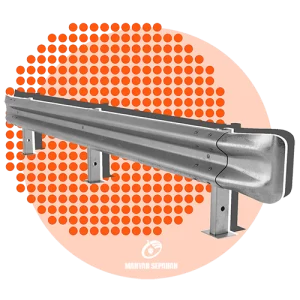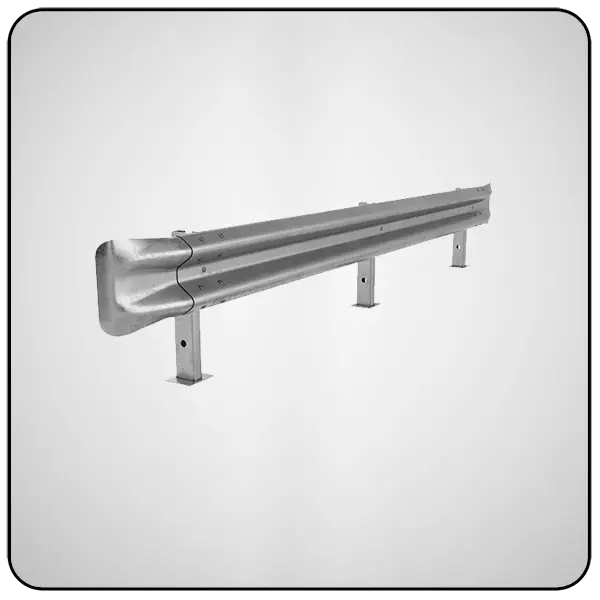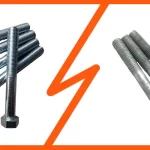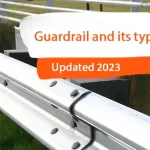road guardrail is an important structure in road construction that increases the safety of drivers and passengers. This structure is installed as a protector between two road boundaries so that in case of an accident, cars do not leave the road.
What is a road guardrail or parapet?
Content list

Along with the growth of communities and vehicles, the need for road and highway security is felt more. Currently, with the aim of increasing the safety factor of roads and cars, as well as controlling some damages caused by traffic accidents and consequently reducing casualties, fences are used on the sides of the roads, which are called guardrails. Guardrails are used to reduce road accidents such as preventing vehicles from falling and being thrown around. Among the types of guard rails, we can mention the two-wave or three-wave types.
Applications of Guardrails:
Roads and highways: Guardrails are widely used on roads and highways to prevent vehicles from veering off course and falling into ditches or colliding with side obstacles.
Bridges: Guardrails are installed on the edges of bridges to prevent vehicles from falling off the bridge.
Intersections: Guardrails are used at intersections to guide traffic and prevent traffic accidents.
Parking lots: Guardrails are used in parking lots to protect cars from colliding with columns and walls.
Types of road guardrails and their use
Guardrails are divided into 3 groups based on their use, which include: side guardrails, middle guardrails, and shock absorbers.
By looking at the table below, you can find out about their use.
| Application | Types of guardrails |
| It is next to the street and to protect from accidents and deviating from the main road. | side |
| In the middle of the roads to separate the back-and-forth lanes It is to prevent traffic. | middle |
| By swerving the vehicle, it prevents the collision of the vehicle. | Bumper |
The side and middle guardrails are divided into three types flexible, semi-rigid, and rigid guards depending on the degree of flexibility.
When buying a road guardrail, you should pay attention to the standard of the country you are looking for, so if you are ordering from a country other than Iran, please mention your desired standard when ordering.
Mehyar Sepahan Company produces and delivers all kinds of guardrails and their bases and separators according to your needs.
Side and median guardrails are classified into three categories based on their flexibility: flexible, semi-rigid, and rigid barriers.
Rigid guardrails:
Rigid guardrails are a type of guardrail that offers high strength and resistance to impact and pressure. They are made of concrete or steel and are typically installed in high-traffic and high-risk areas such as highways, intersections, ramps, and bridges.
Advantages of rigid guardrails:
- High strength and resistance: Rigid guardrails are capable of withstanding heavy impacts and preventing vehicles from veering off course.
- High safety: Due to their high strength, these guardrails protect the lives of drivers and passengers in traffic accidents.
- Long service life: Rigid guardrails have a long life and require less maintenance.
- Easy installation: Installation of these guardrails is quick and easy and does not require special expertise or equipment.
Disadvantages of rigid guardrails:
- High cost: Rigid guardrails are more expensive than other guardrails due to the use of high-quality raw materials.
- High weight: Due to their high weight, these guardrails are more difficult to transport and install.
- Lack of flexibility: Rigid guardrails are less flexible and may damage vehicles upon impact.
Applications of rigid guardrails:
- Highways: Rigid guardrails are widely used on highways to prevent vehicles from veering off course and causing traffic accidents.
- Intersections: These guardrails are used at intersections to guide traffic and prevent traffic accidents.
- Ramps and bridges: Rigid guardrails are used on ramps and bridges to prevent vehicles from falling.
- Hazardous areas: These guardrails are used in hazardous areas such as curves and mountain passes to increase traffic safety.
Semi-rigid guardrails:
Semi-rigid guardrails are a type of guardrail that offers more flexibility than rigid guardrails. They are made of steel and are typically installed in lower-traffic areas such as rural and secondary roads, as well as curves and mountain passes.
Advantages of semi-rigid guardrails:
- Flexibility: Semi-rigid guardrails bend to some extent upon impact with a vehicle, causing less damage to the vehicle.
- High safety: Due to their flexibility, these guardrails prevent vehicles from veering off course and falling into ditches or colliding with side obstacles.
- Reasonable price: Semi-rigid guardrails are less expensive than rigid guardrails due to the use of less raw material.
- Easy installation: Installation of these guardrails is quick and easy and does not require special expertise or equipment.
Disadvantages of semi-rigid guardrails:
- Lower resistance: Semi-rigid guardrails are less resistant to heavy impacts than rigid guardrails.
- Shorter lifespan: Due to their flexibility, these guardrails have a shorter lifespan than rigid guardrails and require more maintenance.
Applications of semi-rigid guardrails:
- Rural and secondary roads: Semi-rigid guardrails are widely used on rural and secondary roads to prevent vehicles from veering off course and causing traffic accidents.
- Curves and mountain pass: These guardrails are used in curves and mountain passes to increase traffic safety and prevent vehicles from veering off course and falling into ditches.
- Lower-traffic areas: Semi-rigid guardrails are used in lower-traffic areas such as parking lots and industrial areas to protect vehicles and pedestrians.
Semi-rigid guardrails: Variety in design and function
Semi-rigid guardrails are designed and manufactured in four different models, each with its own advantages and applications. Here is a brief introduction to each model:
1. Box beam guardrail:
- This type of guardrail has weaker posts and derives its strength from the tension and bending of the box beam section.
- In the event of a collision, the posts break near the point of impact.
- Suitable for low-traffic and low-risk roads.
2. W-beam guardrail with strong posts:
- A wedge placed between the post and the beam minimizes the chances of the vehicle being ripped apart by the posts and thrown over the barrier.
- Suitable for high-traffic and high-risk roads.
3. Three-wave guardrail with strong posts:
- Similar to the two-wave guardrail with wedge, the beam is three-wave, stiffer, and wider, causing less damage to vehicles in the event of a collision.
- Suitable for high-speed and high-traffic roads.
4. Guardrail with modified three-wave beam:
- Has a trapezoidal wedge that, in the event of a collision, bends the lower edge of the beam and the wedge itself, while the surface of the beam remains on the ground.
- Significantly reduces the chances of the vehicle being thrown over the barrier.
- Suitable for curves, mountain passes, and accident-prone areas.
The choice of the right type of semi-rigid guardrail depends on various factors such as the type of road, traffic, speed, and budget.
Flexible guardrails:
Flexible guardrails are a type of guardrail that offers high bending and flexibility capabilities. They are made of steel or plastic and are typically used in areas where there is a risk of vehicles falling, such as curves and mountain passes, as well as on the sides of roads and highways to separate lanes and guide traffic.
Types of flexible barriers:
Three-cable barrier:
- Consists of three steel cables mounted on weak posts.
- It has the ability to restrain and guide vehicles weighing up to 2 tons.
- The advantages of this type of barrier include:
- Low initial cost
- Ability to guide a wide range of vehicles
- Suitable performance in special weather conditions
- No snow and sand accumulation
- The disadvantages of this type of barrier include:
- Need to replace a long length of the barrier after an impact
- Required space behind the barrier
- Limited use in curves
Two-wave beam guardrail:
- It has a similar function to the cable system, but its lateral deformation during impact is much smaller.
- The required space behind these barriers is minimized.
- It has the ability to restrain and guide vehicles weighing up to 8.1 tons.
- The disadvantages of this type of barrier include:
- Sensitivity to installation height
- Need for accuracy in installation
Three-wave beam guardrail:
- Similar to the previous two types, it has weak W-shaped posts.
- Due to the wider width of the beam, it covers a wider range of heights and vehicle types.
- Less sensitive to height changes.
- To prevent the beams from twisting, they must be hooked to the posts alternately from top to bottom.
Advantages of flexible guardrails:
- High flexibility:
Flexible guardrails bend to some extent upon impact with a vehicle, causing less damage to the vehicle.
- High safety: Due to their flexibility, these guardrails prevent vehicles from veering off course and falling into ditches or colliding with side obstacles.
- High visibility: Flexible guardrails are visible at night and in adverse weather conditions due to their bright and reflective colors.
- Easy installation: Installation of these guardrails is quick and easy and does not require special expertise or equipment.
- Reasonable price: Flexible guardrails are less expensive than rigid and semi-rigid guardrails due to the use of less raw material.
Disadvantages of flexible guardrails:
- Lower resistance: Flexible guardrails are less resistant to heavy impacts than rigid and semi-rigid guardrails.
- Shorter lifespan: Due to their flexibility, these guardrails have a shorter lifespan than rigid and semi-rigid guardrails and require more maintenance.
Applications of flexible guardrails:
- Curves and mountain pass: Flexible guardrails are widely used in curves and mountain passes to increase traffic safety and prevent vehicles from veering off course and falling into ditches.
- Sides of roads and highways: These guardrails are used on the sides of roads and highways to separate lanes and guide traffic.
- Areas with a risk of falling: Flexible guardrails are used in areas where there is a risk of vehicles falling, such as bridges and ramps.
- Industrial areas and parking lots: These guardrails are used in industrial areas and parking lots to protect vehicles and pedestrians.
The main difference between rigid, semi-rigid, and flexible guardrails is their flexibility:
• Rigid guardrails:
- Have high strength and resistance to impact and pressure.
- Are installed in high-traffic and high-risk areas such as highways, intersections, ramps, and bridges.
- Have low flexibility and may damage vehicles upon impact.
- Have a high price and high weight.
• Semi-rigid guardrails:
- Have more flexibility than rigid guardrails.
- Are installed in lower-traffic areas such as rural and secondary roads, as well as curves and mountain passes.
- Bend to some extent upon impact with a vehicle, causing less damage.
- Have a reasonable price and lower weight than rigid guardrails.
• Flexible guardrails:
- Have high bending and flexibility capabilities.
- Are used in areas where there is a risk of vehicles falling, such as curves and mountain passes, as well as on the sides of roads and highways to separate lanes and guide traffic.
- Bend to some extent upon impact with a vehicle, causing less damage.
- Have a reasonable price and is easy to install.
- Have lower resistance to heavy impacts and a shorter lifespan than rigid and semi-rigid guardrails.
The choice of the right type of guardrail depends on various factors such as the type of application, the conditions of the site, the budget, and your preference.
Here is a table for a better comparison of these three types of guardrails:
| Property | Rigid Barriers | Semi-Rigid Barriers | Flexible Barriers |
|---|---|---|---|
| Flexibility | Low | High | High |
| Durability and Strength | High | Medium | Low |
| Price | High | Affordable | Affordable |
| Lifespan | Long | Medium | Short |
| Applications | Highways, intersections, ramps, bridges | Rural roads, secondary roads, curves, slopes | Curves, slopes, road margins, highways |
Mehyar Sepehr Guardrails: A guarantee for road safety and your peace of mind
In today’s fast-paced world, driving on roads has become inevitable. However, this traffic always comes with risks, which makes road safety a crucial factor in preventing them. Guardrails, as one of the key elements in road safety, have the critical task of preventing vehicles from veering off course and falling into ditches or colliding with side obstacles.
Our product is a safe and standard guardrail from the Mehyar Sepehr Sepahan brand, which is designed and manufactured using the latest technologies and high-quality raw materials to play a vital role in saving your life in accidents.
Key advantages of Mehyar Sepehr guardrails:
High safety:
- Extremely high resistance: Our guardrails are designed to withstand heavy impacts from vehicles, even heavy vehicles, with extremely high resistance and without separating.
- Preventing vehicles from crossing: These guardrails effectively prevent vehicles from crossing the road and veering off towards side obstacles or ditches.
- No penetration into the vehicle body: In collisions with our guardrails, the guardrail does not penetrate the vehicle body and does not harm the occupants.
Variety in design and model:
Mehyar Sepehr guardrails are produced in various designs and models, according to the needs and conditions of different roads and highways.
Easy installation:
Installation of Mehyar Sepehr guardrails is quick and easy and does not require special expertise or equipment.
Reasonable price:
Mehyar Sepehr guardrails are offered at a reasonable and affordable price.
In addition to high quality, we also attach great importance to the correct installation of guardrails. The team of experts at Mehyar Sepehr Sepahan use modern equipment and install the guardrails with complete precision and accuracy to ensure their strength and stability against impacts and accidents.
Choose Mehyar Sepehr Sepahan safe guardrails and give yourself and your loved ones peace of mind and security.
Mehyar Sepehr Sepahan Company is proud to contribute to improving road safety and saving lives by providing high-quality products and excellent customer service in the field of manufacturing and supplying various types of guardrails.
Some of the services of Mehyar Sepehr Sepahan Company:
- Production and supply of various types of guardrails, their bases, and separators
- Consulting and providing appropriate solutions for road safety
- Installation and commissioning of guardrails by a team of experienced experts
- Providing after-sales services and a valid warranty
When buying a road guardrail, you must pay attention to the standard of the country in question, so if you are ordering from a country other than Iran, please also mention your desired standard when ordering.
For more information and free consultation, contact our experts.
Together with Mehyar Sepehr Sepahan, we make roads safer.



